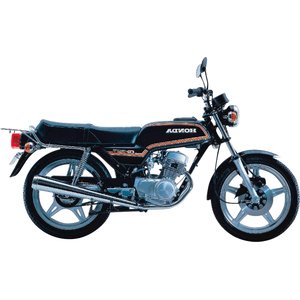Honda CB 125 T2 (1979-1985) Review: A Timeless Twin-Cylinder Classic
Introduction
The Honda CB 125 T2 stands as a fascinating artifact from an era when small-displacement motorcycles weren’t just beginner bikes – they were engineering statements. Produced from 1979 to 1985, this twin-cylinder 125cc machine carved its niche in the lightweight motorcycle segment with a blend of sophistication and simplicity. While modern riders might dismiss 125cc bikes as mere starter machines, the CB 125 T2 demands respect for its mechanical ambition. Let’s explore why this compact twin remains a cult classic and how it holds up today.
Design & Styling
The CB 125 T2 carries the unmistakable DNA of Honda’s CB series from the late 1970s. Its teardrop fuel tank, chrome accents, and dual exhaust pipes scream retro charm. Unlike many single-cylinder commuters of its time, the T2’s parallel-twin engine gives it a balanced, purposeful stance. The 128 kg (282 lbs) curb weight feels remarkably light by modern standards, making it easy to maneuver at low speeds yet stable enough for highway runs.
The analog instrumentation is refreshingly simple – a speedometer, odometer, and basic warning lights. The bench-style seat (a signature of ‘70s design) offers decent comfort for short rides, though taller riders might crave more thigh support. Chrome fenders and spoked wheels complete the vintage aesthetic, though corrosion can be a concern if not maintained properly.
Engine & Performance
Here’s where the CB 125 T2 truly shines. Its 124cc air-cooled parallel-twin engine produces 17 PS (12.5 kW) – modest by today’s standards but revolutionary for a 125cc bike in the late ‘70s. The twin-cylinder configuration delivers smoother power delivery compared to thumpy singles, with a distinctive exhaust note that’s music to any motorcyclist’s ears.
The engine revs freely up to its 10,500 RPM redline, though peak torque arrives early at 8,500 RPM. In real-world riding, this translates to confident acceleration up to 100 km/h (62 mph), with a top speed around 115 km/h (71 mph) – impressive for its class. The 5-speed transmission shifts with Honda’s trademark precision, though the cable-operated clutch requires periodic adjustment to maintain its light feel.
Key maintenance insight from our workshop team:
- Valve clearance: 0.05 mm for both intake and exhaust (cold)
- Spark plugs: NGK CR8HS (7 kW) and CR7HS (12 kW) – crucial to maintain proper electrode gap of 0.6-0.7 mm
- Idle speed: 1,300 ± 100 RPM – easily adjustable via the carburetor’s air screw (1.5 turns out from seated position)
Handling & Ride Experience
Throw a leg over the CB 125 T2, and you’re immediately struck by its neutral riding position. The flat handlebars and mid-set pegs create a comfortable upright posture. At low speeds, the 128 kg (282 lbs) weight disappears beneath you, making it ideal for urban commuting. The 15/39 sprocket combination provides snappy acceleration off the line while maintaining relaxed cruising at 80 km/h (50 mph).
The conventional telescopic forks (105 mL oil capacity per tube) and dual shock absorbers offer a plush ride over imperfect roads. Tire pressures matter here – Honda recommended 1.75 bar (25 psi) front and 2.0 bar (29 psi) rear. Stick to these figures for optimal grip and wear.
Where the T2 truly surprises is in cornering. The narrow 18-inch wheels and lightweight chassis encourage lean angles that would make modern sport bikes blush. The mechanical drum brakes (front and rear) require deliberate input, but they’re more than adequate for the bike’s performance envelope when properly adjusted.
Competition
The CB 125 T2’s twin-cylinder engine set it apart from contemporaries like:
- Yamaha RD125LC (1980-1982):
- Liquid-cooled two-stroke with 22 PS
- Sportier performance but higher maintenance
-
Lacked the T2’s mechanical refinement
-
Suzuki GS125 (1983-1987):
- Single-cylinder air-cooled engine
- 12 PS output – significantly less thrilling
-
Superior fuel economy but bland character
-
Kawasaki AR125 (1981-1985):
- Two-stroke single with 22 PS
- Faster in straight lines but rougher power delivery
- Higher vibration levels at cruising speeds
The Honda’s advantages become clear in daily use: smoother power delivery, lower vibration, and easier maintenance compared to two-stroke rivals. While not the fastest in its class, the T2 offers a uniquely refined riding experience that’s stood the test of time.
Maintenance
As a MOTOPARTS.store journalist, I’ve seen countless CB 125 T2s kept in pristine condition through proper care. Here are key maintenance considerations:
1. Engine Oil
- Use SAE 10W-40 (1.5L with filter change)
- Change every 3,000 km (1,864 miles) – critical for protecting the twin-cylinder’s bearings
2. Chain Care
- 112-link chain requires regular lubrication
- Check tension every 500 km (310 miles)
- Consider upgrading to an O-ring chain for reduced maintenance
3. Carburetor Tuning
- The twin Keihin carbs need syncing every 6,000 km (3,728 miles)
- Clean air filter essential for maintaining the 1.5-turn air screw setting
4. Valve Adjustments
- Check every 4,000 km (2,485 miles)
- 0.05 mm clearance on both valves – use quality feeler gauges
5. Brake Maintenance
- Mechanical drums require periodic shoe inspection
- Upgrade to sintered brake shoes for improved stopping power
Pro Tip from Our Workshop: The stock 15/39 sprocket combo works well for mixed riding, but switching to a 16T front sprocket (-1 tooth) improves highway comfort with minimal acceleration loss.
Conclusion
The Honda CB 125 T2 remains a compelling choice for riders who appreciate mechanical character over raw performance. Its twin-cylinder engine delivers a level of sophistication rarely found in small-displacement bikes, while the straightforward maintenance makes it ideal for DIY enthusiasts. Whether you’re restoring a classic or seeking an affordable vintage commuter, the T2 rewards those who understand its nuances.
At MOTOPARTS.store, we carry everything from NGK spark plugs to period-correct decals for your CB 125 T2. Keep this classic running strong, and it’ll pay you back in miles of analog riding joy.



















